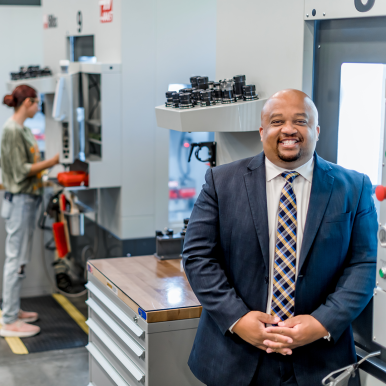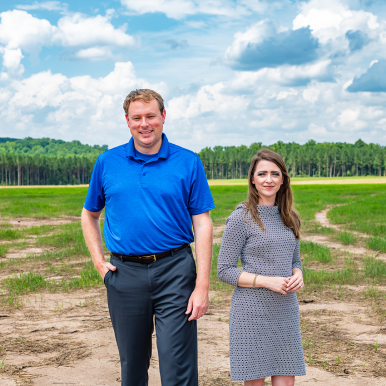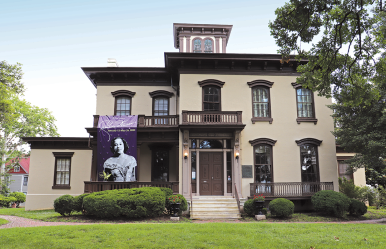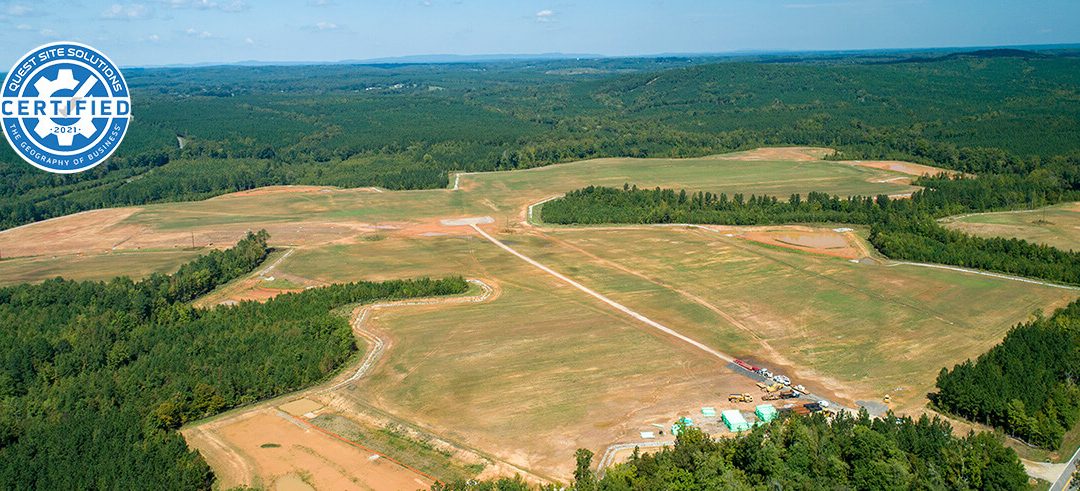Article by: Virginia Business | Written by: Elizabeth Cooper
Thousands of new jobs are flowing into Southern Virginia as Caesars Virginia prepares to open its permanent casino resort next year, and industries move into the region or expand.
Meanwhile, local economic developers have been pitching the vacant 3,500-acre Southern Virginia Megasite at Berry Hill for megaprojects like electric vehicle assembly and battery manufacturing plants that could employ as many as 8,500 people.
But how far will companies have to cast their nets to find workers to fill those positions?
Since 2015, companies have invested more than $1.55 billion in the Danville region, including Pittsylvania and Halifax counties, bringing more than 4,800 jobs to an area still regaining its economic footing following the shuttering of textile, apparel and furniture factories in recent decades.
When considering locations, companies look at the population and available labor force within a 45- to 60-mile radius. According to 2022 U.S. Census figures, just over 136,000 people live in the Danville region, including Pittsylvania and Halifax counties, including nearly 74,000 between ages 20 and 65, but about 1.2 million people reside within 45 to 65 miles. That includes Lynchburg and Roanoke, as well as the North Carolina metropolitan areas of Raleigh-Durham-Chapel Hill and Greensboro-Winston-Salem-High Point. Combined, those areas have a labor shed of more than 540,000 potential workers.
“Our population numbers are extremely impressive,” says Pittsylvania County Economic Development Director Matt Rowe. “That labor force is larger than the one within 60 miles of downtown Richmond.”
Higher-paying positions often attract employees from up to 60 miles away, while lower-skilled jobs can draw workers from within a 45-mile radius. “It comes down to getting as many qualified candidates as possible,” Rowe adds. “It’s in a company’s best interest to cast a wide net for workers – the bigger the funnel, the more fish they can catch, and from there, they can funnel it down to a specific skill set.”
About 30% of workers drive into the region, while approximately 13,000 Danville and Pittsylvania residents commute outside the area for job opportunities, says Corrie Bobe, Danville’s economic development director. “That’s a great market for new and existing industries to target. If people have the opportunity to remain here and not have to drive distances for quality jobs, they would prefer to do so.”
‘Building a pipeline’
The outflow includes residents who gained skills through local workforce training programs. Over the past decade, Danville and Pittsylvania County have allocated more than $70 million to ensure a pipeline of skilled workers, an investment Bobe touts to prospective industries. As part of site visits, business representatives tour local educational institutions, including Danville Community College, the Institute for Advanced Learning and Research (IALR) and middle and high schools where IALR’s GO TEC (Great Opportunities in Technology and Engineering Careers) program introduces students to the possibilities of careers in manufacturing. “Companies have been blown away by the large number of skilled [workers] that are training and have been trained here,” she says.
Established two decades ago to diversify Southern Virginia’s economy, IALR provides training in skills such as advanced manufacturing, information technology, automotive manufacturing and cybersecurity. “We’re building a pipeline of skilled workers,” says IALR President Telly Tucker. “Our strategy is to produce a well of talent because companies want to be close to … talent.”
Last fall, IALR opened its $28.8 million Center for Manufacturing Advancement, which provides new or expanding companies space to collaborate and integrate emerging and new technologies. The U.S. Navy also opened its Additive Manufacturing Center of Excellence at IALR to expand the military’s industrial base and provide defense contractors with workers trained in additive manufacturing. In addition, IALR hosts the Department of Defense’s Accelerated Training in Defense Manufacturing, a four-month program that trains workers from throughout the U.S. for jobs in the defense industry. About 800 to 1,000 workers are expected to complete the program by 2025.
IALR’s partnerships with businesses, high schools and community colleges show students the abundance of career options in their own backyard, adds Todd Yeatts, the institute’s executive vice president of manufacturing advancement. “Students with associate degrees or an adult with work experience can get industry credentials to allow them to step into leadership positions. It gives students an opportunity to pursue their dreams.”
Tucker believes that many students graduating from IALR programs will take advantage of increasing job prospects in Southern Virginia, reversing a population decline fueled by the exodus of textile and manufacturing jobs. “Many people will choose to stay in the region if jobs are available with good wages,” he says. “We’ll see a reverse of the population decline.”
Mark Funkey, who came to Danville Community College in January as vice president of workforce services, has been meeting with local businesses to determine their staffing needs. “There is a ton of need in the manufacturing industry for maintenance technicians, robotics and automation,” he says. “We’re working on developing customized training to focus on what individual companies need to fill their workforce or upscale the workforce they already have to take on higher level technical jobs.”
The challenge is getting the training programs up and running. “We have to have industry professionals to teach skills and the space and money to build or lease a building,” he adds. “These kinds of things are not inexpensive and don’t happen overnight.”
Funkey also has identified about 15,000 people in Danville and Pittsylvania and Halifax counties who have a GED or are eligible to obtain one. He wants to establish a program at the college to help residents earn their GED and move into workforce training. “Most jobs that need filling have skill components,” he notes. “We’re trying to get folks to attain the skills to be able to access those opportunities.”
He acknowledges there may not be enough locals to fill the influx of jobs. “We are limited in population. That’s a struggle, but we are working to the best of our ability to build the workforce. That’s why it’s important to upscale the local workforce.”
Trend reversal
U.S. Census figures show the region’s population declined by 9% between 2000 and 2021, with the prime working age group between 20 and 50 dropping by 27%. However, between 2020 and 2022, Danville saw a net gain of 509 more residents moving into the city than those leaving, though the overall population decreased slightly due to 751 deaths among the city’s aging populace during the same time period, according to a report from the Weldon Cooper Center for Public Service at the University of Virginia.
Linda Green, executive director of the Southern Virginia Regional Alliance, takes the increased migration to Danville as a good sign. “We’re seeing a new trend that reverses the population decline,” she says. “People are moving here for jobs with highly competitive wages.”
Green believes also that a cultural shift is occurring as middle and high school students are exposed to career paths in technology and consider staying in the area. “We’re used to seeing sports banners hanging in local high school gyms,” she says. “Now we’re seeing banners recognizing student accomplishments in technology competitions. It’s saying our programs are validated by some of the top companies in the nation. That impresses companies looking to move into the region.”
Danville and Pittsylvania County officials highlight the region’s skilled workforce when attempting to woo industries to the Southern Virginia Megasite at Berry Hill.
Earlier this year, Albemarle Corp. considered establishing a $1.3 billion lithium hydroxide processing facility at Berry Hill before choosing property in South Carolina, creating 300 jobs. The megasite also was in contention for Hyundai’s $5.5 billion electric vehicle assembly plant, which would have brought 8,500 jobs to the area, but the auto manufacturer selected a site near Savannah, Georgia. Additionally, in December 2022, Gov. Glenn Youngkin took the megasite out of the running for a $3.5 billion Ford Motor Co. electric vehicle battery factory over concerns that a Chinese company would be operating the facility; Ford instead chose a Michigan site for the plant, which is creating 2,500 manufacturing jobs.
Workforce issues did not factor into any of those rejections, says Bobe. “The access to talent has not been a component for the megasite being eliminated from projects. Usually, that’s our very strong point.”
In fact, the region’s labor pool played a large role in IperionX Ltd.’s decision last year to open its recycled titanium metal powder facility in South Boston. The Charlotte, North Carolina-based mineral company is investing $82.1 million and plans to hire more than 100 employees by 2025, with the potential for expansion, says IperionX founder and CEO Anastasios “Taso” Arima.
“Excellent community support, excellent infrastructure and political structure and a strong community workforce training program really made the choice straightforward to move to Southern Virginia,” Arima adds. “A lot of training programs are already in place to develop the labor we need, and we’re confident that we will be able to secure a labor force from a 45-minute to an hour’s drive away.”
Selling points
Caesars Virginia also expects to hire employees from within a 45-minute drive’s radius of Danville for its $650 million permanent resort hotel and casino, expected to open in late 2024. “That was the thinking that people would be willing to drive for a job,” says the casino’s general manager and senior vice president, Chris Albrecht, “but we’ve definitely gotten interest from areas beyond that.”
The multimillion-dollar resort casino opened a temporary facility this spring with about 400 workers; casino management plans to have about 1,300 employees onboard when the permanent casino opens. Caesars has held hiring events, including one in Greensboro, and participated in career fairs at colleges and universities in Virginia and North Carolina.
Most of the casino’s employees so far live in the Danville area, Albrecht adds, with some transferring to the region from other Caesars facilities. “In the first wave of jobs, we were able to get employees from within 45 minutes. We’ll consider more options as the permanent facility gets built.”
Since arriving in Danville last year, Albrecht has been impressed with the area’s revitalization efforts. “The city has a lot of great economic development, and we’re looking forward to the casino helping bring further development to the area.”
About $50 million in public funds and $355 million in private monies have been invested in revitalizing Danville’s River District as a catalyst for attracting people back to the city. “Now it’s an attractive place for visitors and residents to enjoy,” says Bobe. “We look forward to substantial population growth in our community and are preparing for both the city and county to grow significantly.”
The projected growth is driving up demand for single and multifamily homes. An average of only 10 single-family dwellings have been built in Danville each year during the past decade, and officials say about 2,400 new units are needed for the influx of new workers.
The city has identified several areas for construction or rehabilitation, including the struggling Danville Mall and the 60-acre Monument-Berryman Redevelopment Area. “We have a large pipeline for new housing options in development, whether in permitting or under construction, in both the city and the county,” notes Bobe.
Regional and national developers got a firsthand look at residential development opportunities during the Southern Virginia Regional Housing Summit last August. A second conference is scheduled for September. “National developers are already in the Raleigh-Durham and Greensboro areas,” says Pittsylvania’s Rowe. “It’s an easy process for them to come here, but our market has been neglected.”
Growing up in Pittsylvania, David Bennett was eager to leave the rural community as soon as he graduated from high school in 1980. “The minute I could go, I took off,” Bennett recalls. He returned seven years later after he accepted a job with Intertape Polymer Group Inc., a packaging products and systems company in Ringgold. In the interim, he’s come to appreciate Southern Virginia and its amenities.
“There have been a lot of improvements in schools, health care and housing,” Bennett says. He adds that many Intertape managers and technical staff have built homes in the area, a shift from just a few years ago when many salaried employees commuted from Greensboro. “The quality of life in this area is terrific. We’ve set up Danville to be successful.”
IALR’s Tucker says quality of life and cost of living are Southern Virginia’s main selling points. “There’s tremendous value in being a resident of this region. We have a lower cost of living, less traffic congestion and access to metro areas within an hour. Great things are happening in Southern Virginia.”
Southern Virginia at a glance
Running along a large stretch of the Virginia-North Carolina border, Southern Virginia includes Brunswick, Charlotte, Greensville, Halifax, Henry, Lunenburg, Mecklenburg, Patrick and Pittsylvania counties, plus the cities of Danville, Emporia and Martinsville. Once rooted in tobacco processing and textile manufacturing, the area has pivoted toward becoming an advanced manufacturing hub known for its innovative workforce training. Area higher education institutions include Averett University, Danville Community College, New College Institute, Patrick & Henry Community College and Southside Virginia Community College. The Institute for Advanced Learning and Research is a regional catalyst for workforce development, manufacturing advancement and economic development.

Population
Danville: 42,348
Martinsville: 13,234
Pittsylvania County: 59,366
Halifax County: 33,257
Mecklenburg County: 30,179
Henry County: 48,835
Patrick County: 17,080
Brunswick County: 15,849
Lunenberg County: 11,936
Greensville County: 11,391
Charlotte County: 11,029
Emporia: 5,766
Top Employers
Goodyear Tire & Rubber Co.
Sovah Health
Hooker Furnishings Corp.
Eastman Performance Films LLC
Monogram Food Solutions LLC
Bassett Furniture Industries Inc.
Morgan Olson LLC
Tyson Foods
Nestlé Refrigerated Food Co.
Springs Global U.S. Inc.
Professional Sports
Martinsville Speedway is a short track — half a mile — and hosts multiple major NASCAR race weekends each year in the spring and the fall. With a 3.27-mile road course, Virginia International Raceway hosts multiple race weekends each year, including its biggest event, the International Motor Sport Association (IMSA) Weathertech Championship in late August.
Major Attractions
While auto racing is the region’s top draw, other attractions include the Virginia Museum of Natural History, with dinosaur and prehistoric whale fossils; the AAF Tank Museum, which has more than 120 armored tanks and artillery pieces on exhibit; Danville Science Center; and the Danville Museum of Fine Arts & History. Danville’s downtown River District features bars, restaurants, shopping and boutique hotel The Bee. For those who like to get outdoors, hike the scenic Riverwalk Trail or go kayaking, rafting and tubing on the Dan River.

